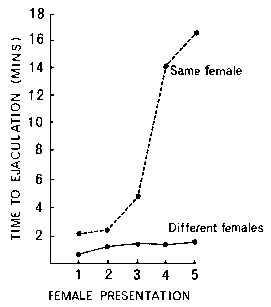
|
The Psychology of SexGlenn Wilson on the Coolidge Effect |
The males of most mammalian species have a definite urge towards seeking variety in their in sexual partners. In the laboratory this has been called the ‘Coolidge Effect’ (Bermant, 1976). If a male rat is introduced to a female rat in a cage, a remarkably high copulation rate will be observed at first. Then, progressively, the male will tire of that particular female and, even thought there is no apparent change in her receptivity, he eventually reaches a point where he has little apparent libido. However, if the original female is then removed and a fresh one supplied, the male is immediately restored to his former vigour and enthusiasm.
The same effect is seen even more strikingly in farm animals such as sheep and cattle (see Figure, a demonstration of the Coolidge Effect in sheep, from Beamer, Bermant and Clegg, 1960). Rams and bulls are unmistakably resistant to repeating sex with the same female (Beamer, Bermant and Clegg, 1969). Thus for breeding purposes it is unnecessary for a farmer to have more than one male to service all his sheep and cows. A single bull can be relied upon to do the rounds of all the available cows, and a single ram will eventually service all the sheep in his domain.

Donald Symons (1979) of the University of California, Santa Barbara, has pointed out that the term ‘indiscriminate’ has been applied inaccurately to male sexuality. Male animals do not choose their mates randomly; they identify and reject those that they have already had sex with. In the case of rams and bulls it is notoriously difficult to fool them that a female is unfamiliar. Attempts to disguise an old partner by covering her face and body or masking her vaginal odours with other smells are usually unsuccessful. Somehow she is identified as ‘already serviced’ and the male moves on to less familiar females. W. S. Gilbert’s assertion that ‘love unchanged will cloy’ (Trial by Jury) seems to apply with a vengeance down on the farm.
Bermant (1976) has given an amusing, if somewhat apochryphal, account of the origin of the term ‘Coolidge Effect.’ The story goes that President and Mrs Coolidge were visiting a government farm in Kentucky one day and after arrival were taken off on separate tours. When Mrs Coolidge passed the chicken pens she paused to ask her guide how often the rooster could be expected to perform his duty. ‘Dozens of times a day’ was her guide’s reply. She was most impressed by this and said, ‘Please tell that to the President.’ When the President was duly informed of the rooster’s performance he was initially dumbfounded. Then a thought occurred to him. ‘Was this with the same hen each time?’ he inquired. ‘Oh no, Mr President, a different one each time’ was his host’s reply. The President nodded slowly, smiled and said, ‘Tell that to Mrs Coolidge!’
Although the Coolidge Effect is somewhat diminished in force within primates, and perhaps especially so in humans who have moral compunctions to deal with in addition, vestiges of it are nevertheless apparent. Before marriage it is usual for men to initiate intercourse at a fairly high frequency with their fiancée. After a few years of marriage, however, the husband’s sexual appetite begins to wane and an apparent reversal of libido may even occur, with the now frustrated wife demanding more love-making than her ‘tired’ husband is able to supply. He, of course, is still perfectly capable of being aroused by his mistresses and office girls and, if fortunate enough to secure an invitation to an orgy, would have little difficulty completing intercourse with two or three anonymous young women in the course of the evening’s festivities. Sex therapists see many men who are reported as ‘impotent’ by their wives but who privately confess to considerable prowess with a succession of mistresses. Clearly, this is more of a social problem than a medical condition.
Data illustrating the Coolidge Effect in human beings have been reported by Wilson (1981a). Large samples of men and women were asked if they were ‘getting enough sex at the moment,’ 56 per cent of men and 41 per cent of women replying that they were not. When asked what their ideal would be, 63 per cent of women said ‘more sex with their spouse or steady partner’ (compared with 38 per cent of men) and 37 per cent of men said ‘more partners’ (compared with 18 per cent of women). Separation of the data into results for people of two different generations (younger and older than thirty) showed no change in this sex difference as a result of the new climate of sexual equality in which the younger generation has been raised (Table, from Wilson, 1981b). Evidently partner variety is of greater interest to men than to women, and this difference is reliable and enduring.
| Table Male and female conceptions of the ideal sex life (in percentages) | ||||
|
Male
(N=1,862) |
Female
(N=2,905) |
|||
| Age | <30 | >30 | <30 | >30 |
| Not getting enough sex at the moment
If not enough, then ideal would be: |
55 | 56 | 41 | 41 |
| (a) more sex with spouse or steady partner | 37 | 38 | 62 | 63 |
| (b) more exciting variations with partner | 34 | 38 | 24 | 26 |
| (c) more partners | 38 | 37 | 20 | 18 |
Glenn Wilson, The Great Sex Divide, pp. 41-45. Peter Owen (London) 1989; Scott-Townsend (Washington D.C.) 1992.